 W
WAmiral Cécille was a protected cruiser of the French Navy, named in honour of Jean-Baptiste Cécille. The third vessel of that type built in France, her design was derived from her two predecessors, Sfax and Tage. Like those vessels, Amiral Cécille was intended to be used as a commerce raider to attack merchant shipping. As such, she carried a barque sailing rig to supplement her steam engines for long voyages overseas. Amiral Cécille was armed with a main battery of eight 164 mm (6.5 in) guns and had a curved armor deck that was 56 to 102 mm thick.
 W
WAréthuse was an unprotected cruiser built for the French Navy in the late 1870s and early 1880s.
 W
WChâteaurenault was a steam corvette of the French Navy. Originally designed as a commerce raider, she notably served in the Mediterranean during the tense era before the Russo-Ottoman War of 1877–1878, and took part in the Tonkin campaign and the Sino-French War.
 W
WChâteaurenault was a large protected cruiser built for the French Navy in the late 1890s and early 1900s. She was intended to serve as a long-range commerce raider, designed according to the theories of the Jeune École, which favored a strategy of attacking Britain's extensive merchant shipping network instead of engaging in an expensive naval arms race with the Royal Navy. As such, Châteaurenault was built with a relatively light armament of just eight medium-caliber guns, but was given a long cruising range and the appearance of a large passenger liner, which would help her to evade detection while raiding merchant shipping.
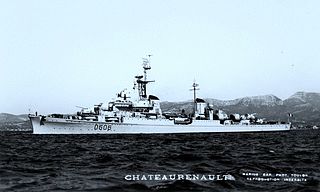 W
WChateaurenault was a French Capitani Romani-class light cruiser, acquired as war reparations from Italy in 1947 which served in the French Navy from 1948 to 1961. She was named in honour of François Louis de Rousselet, Marquis de Châteaurenault. In Italian service, the ship was named Attilio Regolo after Marcus Atilius Regulus the Roman statesman and general who was a consul of the Roman Republic in 267 BC and 256 BC.
 W
WD'Entrecasteaux was a large protected cruiser built for the French Navy in the 1890s. The only vessel of her class, D'Entrecasteaux was intended to serve as a flagship of the cruiser squadron that defended French Indochina and other possessions in the Far East. Her construction came during a period of conflict in the French naval command between factions that favored different cruiser types; D'Entrecasteaux represented the ideas of the Jeune École, who favored large cruisers for long-range operations overseas. She was armed with a main battery of two 240 mm (9.4 in) guns, the largest guns ever carried aboard a French cruiser, though their great weight, coupled with her pronounced ram bow degraded her seaworthiness. She nevertheless provided the basis for later armored cruisers.
 W
WDavout was a protected cruiser of the French Navy that was built in the late 1880s and early 1890s. The ship was ordered during the tenure of Admiral Théophile Aube as the French Minister of Marine, who favored a fleet centered on large numbers of cruisers of various types. Davout and the similar vessel Suchet were ordered to fill the role of a medium cruiser in Aube's plans. Davout was armed with a main battery of six 164 mm (6.5 in) guns in single mounts, and she had a top speed of 20.7 knots.
 W
WDubordieu was an unprotected cruiser built for the French Navy in the early 1880s.
 W
WThe Dupleix class consisted of three armored cruisers built for the French Navy at the beginning of the 20th century. Designed for overseas service and armed with four 164.7-millimeter (6.5 in) guns, the three ships of the class were smaller and less powerfully armed than their predecessors.
 W
WDupuy de Lôme was an armoured cruiser built for the French Navy during the late 1880s and 1890s. She is considered by some to be the world's first armoured cruiser and was intended to attack enemy merchant ships. The ship was named after the naval architect Henri Dupuy de Lôme. Dupuy de Lôme's completion was delayed by almost two years by problems with her boilers, but she was finally commissioned in 1895 and assigned to the Northern Squadron, based at Brest, for most of her career. The ship made a number of visits to foreign ports before she began a lengthy reconstruction in 1902. By the time this was completed in 1906, the cruiser was regarded as obsolete and Dupuy de Lôme was placed in reserve, aside from one assignment in Morocco.
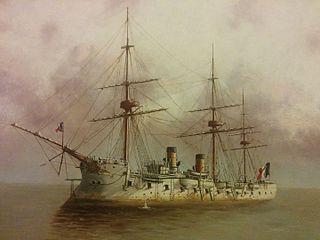 W
WThe French cruiser Duquesne was an unprotected cruiser built for the French Navy. It was the sixth ship in the French Navy to be named for Abraham Duquesne. The ship was laid down at Arsenal de Rochefort in 1873 and launched in 1876. It was struck in 1901.
 W
WErnest Renan was an armored cruiser built for the French Navy in the first decade of the 20th century. At the outbreak of World War I in August 1914, she participated in the hunt for the German battlecruiser SMS Goeben and then joined the blockade of the Austro-Hungarian Navy in the Adriatic. She took part in the Battle of Antivari later in August, and the seizure of Corfu in January 1916, but saw no further action during the war. After the war, the British and French intervened in the Russian Civil War; this included a major naval deployment to the Black Sea, which included Ernest Renan. She served as a training ship in the late 1920s before she was sunk as a target ship in the 1930s.
 W
WGuichen was a large protected cruiser built in the 1890s for the French Navy, the only member of her class. She was intended to serve as a long-range commerce raider, designed according to the theories of the Jeune École, which favored a strategy of attacking Britain's extensive merchant shipping network instead of engaging in an expensive naval arms race with the Royal Navy. As such, Guichen was built with a relatively light armament of just eight medium-caliber guns, but was given a long cruising range and the appearance of a large passenger liner, which would help her to evade detection while raiding merchant shipping.
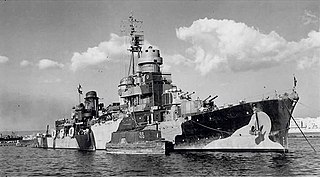 W
WGuichen was a French Capitani Romani-class light cruiser, acquired as war reparations from Italy in 1947 which served in the French Navy from 1948 to 1961. It was named in honour of Luc Urbain de Bouëxic, comte de Guichen. In Italian service, it was named Scipione Africano after Publius Cornelius Scipio Africanus, the Roman general and later consul.
 W
WJeanne d'Arc was an armoured cruiser built for the French Navy at the end of the 19th century, the sole ship of her class. Completed in 1903, she was initially assigned to the Northern Squadron, although she was transferred to the reserve fleet before the end of the year. The ship was recommissioned for a few months in mid-1905 and was transferred to the Mediterranean Fleet in mid-1906 and served as a flagship for the next several years. Jeanne d'Arc was assigned to the reserve in mid-1908 and modified to serve as a training ship for naval cadets of the Naval Academy. In 1912, she made the first of two lengthy training cruises.
 W
WJeanne d'Arc was a training cruiser built for the Marine Nationale during the late 1920s. She was designed both as a school ship and a fully capable warship. She saw service through the Second World War, escaping to Halifax after the fall of France and eventually joining the Free French forces before the end of the war. Post war, the cruiser resumed her duties as a training ship, being retired in 1964.
 W
WJeanne d'Arc was a helicopter cruiser of the French Navy. She was the sixth vessel of the French Navy named after Joan of Arc, a national heroine of France and saint of the Catholic Church who led the French to victory during the final phases of the Hundred Years' War.
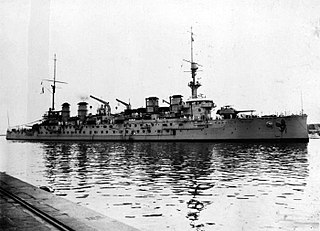 W
WJules Michelet was an armoured cruiser of the French Navy, laid down in 1904 and completed in 1908. It was a development of the Léon Gambetta class of armoured cruisers, and was the sole representative of its type. It served during the First World War being eventually sunk as a target in 1937.
 W
WJurien de la Gravière was a protected cruiser built for the French Navy in the late 1890s and early 1900s, the last vessel of that type built in France. Intended to serve overseas in the French colonial empire, the ship was ordered during a period of internal conflict between proponents of different types of cruisers. She was given a high top speed to enable her to operate as a commerce raider, but the required hull shape made her maneuver poorly. The ship also suffered from problems with her propulsion machinery that kept her from reaching her intended top speed. She carried a main battery of eight 164 mm (6.5 in) guns and was protected by a curved armor deck that was 35–65 mm (1.4–2.6 in) thick.
 W
WSMS Königsberg was the lead ship of the Königsberg class of light cruisers, built for the German Imperial Navy during World War I. She took the name of the earlier Königsberg, which had been destroyed during the Battle of Rufiji Delta in 1915. The new ship was laid down in 1914 at the AG Weser shipyard, launched in December 1915, and commissioned into the High Seas Fleet in August 1916. Armed with eight 15 cm SK L/45 guns, the ship had a top speed of 27.5 kn.
 W
WMilan was a late-19th-century unprotected cruiser in the French Navy. At the time of her completion, Milan was considered by several publications to be the fastest warship in the world. The warship was the last unprotected cruiser in French naval service, and Milan's design influenced the construction of later protected cruisers.
 W
WNaïade was an unprotected cruiser of the French Navy that was built in the late 1870s and early 1880s.
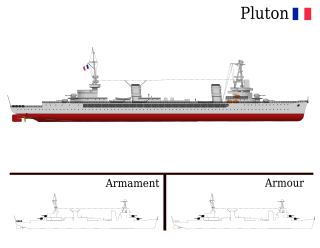 W
WPluton was a fast minelaying cruiser built for the French Navy in the late 1920s. She was also able to carry 1,000 troops on her mine deck as a fast troop transport. Shortly after completion she was modified and became a gunnery training ship, replacing the elderly armored cruiser Gueydon. Shortly before the beginning of World War II, she reverted to her original role and most of the gunnery training equipment was removed. She was sent to Casablanca, in French Morocco, when the war began to lay a minefield, but the order was cancelled a day later and she was ordered to disembark her naval mines. She exploded while landing her still-fuzed mines on 13 September 1939.
 W
WThe French cruiser Pothuau was an armoured cruiser built for the French Navy in the 1890s. She spent most of her active career in the Mediterranean before becoming a gunnery training ship in 1906. The ship participated in the Kamerun Campaign early in World War I before she was transferred to the Red Sea and the Indian Ocean in 1916 where she patrolled and escorted convoys. Pothuau fruitlessly searched the Indian Ocean for the German commerce raider Wolf in mid-1917. The ship resumed her previous role after the war until she was decommissioned in 1926 and sold for scrap three years later.
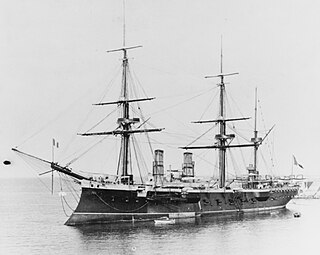 W
WSfax was a protected cruiser built for the French Navy in the 1880s. She was the first vessel of the type to be built for the French Navy, which was a development from earlier unprotected cruisers like Milan. Unlike the earlier vessels, Sfax carried an armor deck that covered her propulsion machinery and ammunition magazines. Intended to be used as a commerce raider in the event of war with Great Britain, Sfax was rigged as a barque to supplement her engines on long voyages abroad. She was armed with a main battery of six 164 mm (6.5 in) guns and a variety of lighter weapons.
 W
WSMS Regensburg was a light cruiser of the Graudenz class built by the German Kaiserliche Marine. She had one sister ship, SMS Graudenz. The ship was built by the AG Weser shipyard in Bremen, laid down in 1912, launched in April 1914, and commissioned into the High Seas Fleet in January 1915. She was named for the German town of Regensburg. The ship was armed with a main battery of twelve 10.5 cm SK L/45 guns and had a top speed of 27.5 knots, though in 1917 she was rearmed with seven 15 cm SK L/45 guns.
 W
WSuchet was a protected cruiser of the French Navy built in the late 1880s and early 1890s. The ship was ordered during the tenure of Admiral Théophile Aube as the French Minister of Marine, who favored a fleet centered on large numbers of cruisers of various types. Suchet and the similar vessel Davout were ordered to fill the role of a medium cruiser in Aube's plans; the two cruisers were meant to be identical, but problems during Davout's construction forced design changes to Suchet, resulting in two unique vessels rather than a single class. Suchet was armed with a main battery of six 164 mm (6.5 in) guns in individual mounts and had a top speed of 20.4 knots.
 W
WTage was a protected cruiser built for the French Navy in the 1880s, the second vessel of that type built for the French fleet. The design was based on the previous cruiser, Sfax, and like that vessel, Tage was intended to be used as a commerce raider to attack merchant shipping. As such, she carried a barque sailing rig to supplement her steam engines for long voyages overseas. Tage was armed with a main battery of eight 164 mm (6.5 in) guns and had a curved armor deck that was 51 to 56 mm thick.